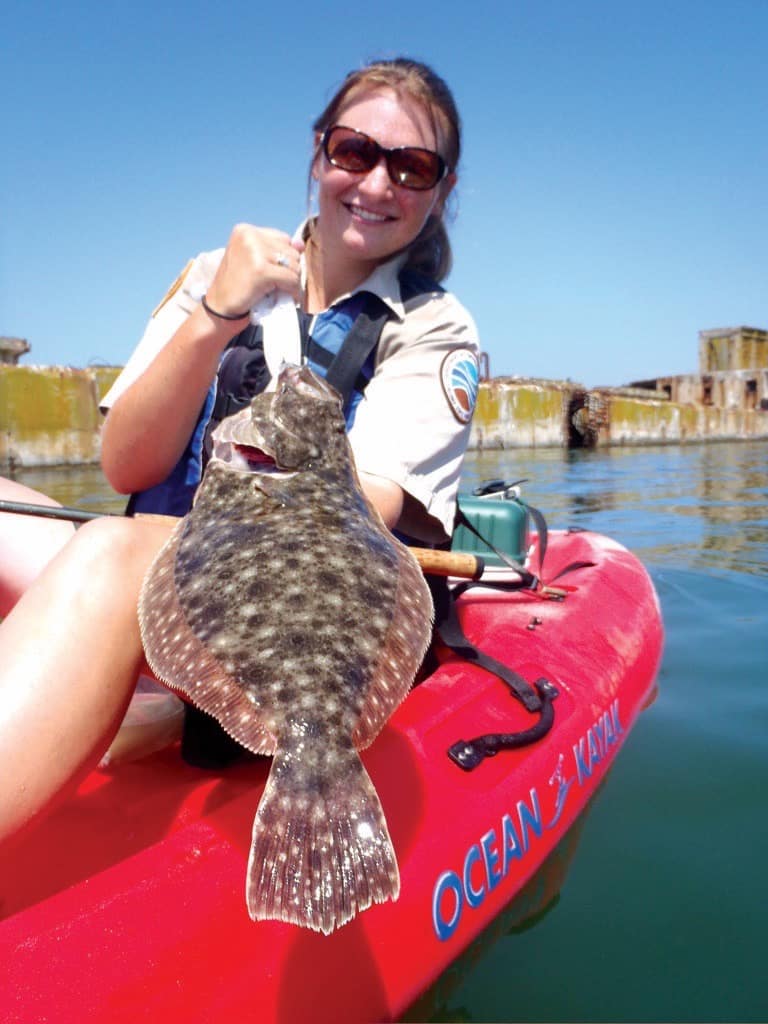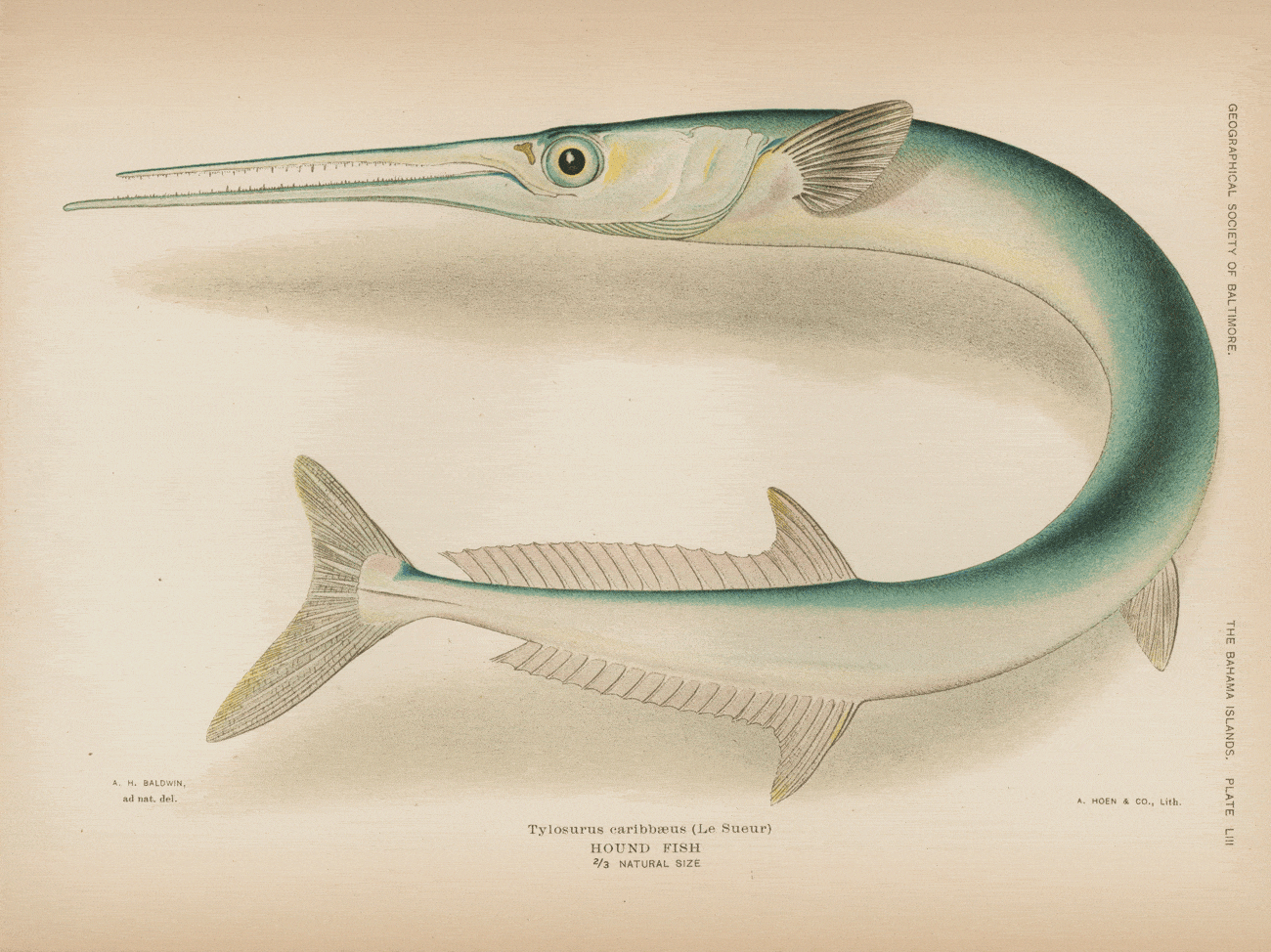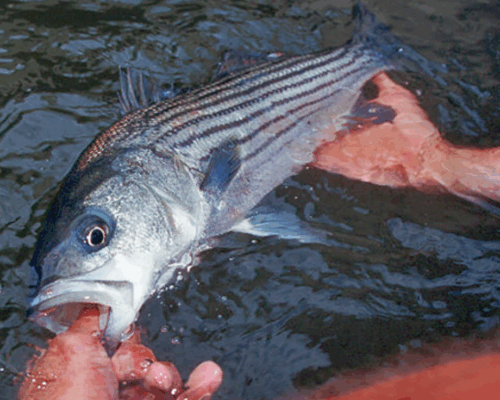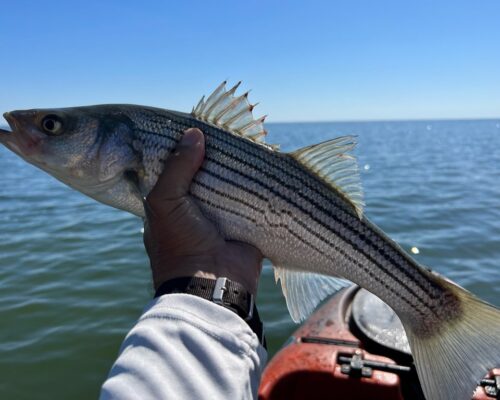Summer flounder tips, tactics, tricks and locations.
Although rockfish grab most of the attention in my neck of the woods, the well-rounded angler would do well to carve out time this season to fish for summer flounder, also called “fluke.” This quality gamefish is more popular in the Virginia waters of the Chesapeake than in Maryland, and for good reason: There are more of them there, and they are bigger.
Springtime on the Flats
Flounder fishing gets going in mid-to late spring in the coastal bays of Delmarva, a beautiful place for both them and us to hang out this time of year. When the bite is on, anglers tired of a long, windy winter, chomping at the bit to catch fish, will ply the waters that weave in and around the Atlantic’s back bays.
Focus your efforts on areas where there’s a reliable exchange of cold water for relatively warmer water. These places attract bait fish, which attract flounder looking to get needed calories on board. Virginia’s Chincoteague and Wachapreague islands are two the more popular spots to target spring flounder, particularly in the guts, flats and channels. Since it’s been a cold spring, don’t be surprised if flounder fishing kicks into gear later than usual. Overall, flounder action in our region runs from April through November.
The early flounder season is determined by water temperature since flounders are semi-endothermic, meaning the bigger the fish the colder the water it can actively feed in. In the spring, that can translate into fewer hits, but the keeper ratio is usually higher. Flounder pounders—the most committed flatfish fanatics—begin to seriously target flounder when the water temps hits the mid-50s mark, searching for that magic 60 degrees.
Summer & Fall Go-Tos
By the time summer rolls in, flounder are more abundant both on the
seaside and in the Chesapeake. The game changes somewhat as fish take up station on structure as well as hover over the flats. In Ocean City, spots worth fishing from summer into early fall include in front of Castaways Campground, natural bottom between “A” and “B” Buoys, and the East Channel into the Thorofare. When summer begins to wane, try the wrecks and reefs, such as the African Queen, a reef site that can produce keeper fluke as well as the occasional doormat. It’s an easy run, about
13 miles southwest of the Ocean
City Inlet.
In Virginia, the myriad reefs, wrecks and bridges can hold big flounder. Hotspots include the 3rd and 4th island of the Chesapeake Bay Bridge Tunnel, the Cell, Back River Reef, and the Cape Henry Wreck. Later in the year as waters cool, the action shifts to ocean structures that include the Triangle Reef, the Tower Reef, and the Brass Spike.
Tactics & Techniques
Early in the season is a good time to slow troll. This is when an electric trolling motor earns its keep, especially when the tide goes slack, and the drift becomes too slow or even non-existent. Sans a trolling motor, you can also bump the main boat engine in and out of gear. Find the edges and ledges of the channels where there is a steep drop in depth. You’ll want to drag your bait on the bottom from shallower to deeper, occasionally “working the bait;” meaning lightly “pop” the rod tip to give fish-attracting action to your lure.
Expert flounder anglers I’ve fished with insist that I resist the urge to set the hook on an initial bump. Flounder have small mouths, so they take in baits conveyor bait style, proportionally, rather than all at once, like other gamefish. This makes your line feel heavier than the traditional hard strike you’d feel from a drum or striper. When you get a hit, rather than set the hook, drop the bait back to the fish by opening the bail on the spinning reel or thumbing the spool in free on a conventional reel. Patience is key—easier said than done for this angler. Give the fish time to swallow the whole enchilada. Once they do, close the bail, and set the hook. Hookup rates improve for those who can adhere to this discipline.
Later in the season, fresh bait, especially from oily species like bluefish or mackerel, cut in similar patterns do well. Note: It’s legal to use the belly meat of a legally caught fish as long as you keep the head and tail intact.
Around the Bay Bridge Tunnel, big doormat flounder are known to inhale live spot. The standard minnow/squid or specialty pre-made rigs like Fluke Killers, as well as finger mullet, shiners and squid also bring strikes. Drifting and jigging artificial baits can work, too. Gulp! and Z-Man come to mind.
You can buy or build your own flicker rig using an egg or bullet sinker, a cork float to keep the bait off the bottom, a swivel connection to keep it from twisting, and small plastic beads and a spinner blade to create flounder-attracting vibration. Tie-on a wide-gap, 1/0 to 4/0 Kahle or similar hook at the end. This rig works well when drifting live bait over reefs and rockpiles.

Some Virginia charter captains and experts catch big flounder while anchored over structure by casting live spot or mullet up-current and letting the current carry the lively morsel over a patch of live bottom. They use a three-way swivel with a sinker on a
12- to 15-inch leader to one ring and a Kahle-style hook with a 36-inch leader to the other ring. I prefer to keep things pretty simple. I’ve borrowed from guides who regularly target flounder as well as sport anglers dialed into these fish to settle on what has worked for me. One of my favorites is a one- to two-ounce bucktail style jig. I like Specialized Baits’ Lil’ Jimy and Addiction Baits skirted bucktails. You can tip them with a large, live shiner or tapered, six-inch or shorter, strips of fresh squid. It’s a killer when fished right.
I like my fast-action, seven-foot Mojo inshore, bait-caster rod for this pursuit. Other, perhaps more avid, flounder anglers go with with conventional style reels because it’s easier to control the line when you drop the lure back to the fish. I spool up with 30- or 40-pound PowerPro braided line and 25- to 30-pound fluorocarbon leader joined with a double uni knot.
Fly-rodders can get in on the fun, too. Fishing from kayaks, stand-up paddle boards or wet wading the flats are stealthy ways to stalk flounder. There are plenty of places to try this along Delmarva’s back bays and even some ocean-side flats. Cape Henlopen in Delaware fits that bill; it’s a good spot when the weather patterns have settled. Eight-weight outfits with sink-tip or intermediate sinking lines work best. Crab, shrimp and minnow fly patterns are the best choices.
What Happened to the Flounder in Maryland’s Chesapeake?
By now you’ve probably figured out that your best shot at a keeper flounder is on the seaside or in in Virginia’s part of the Bay. In fact, landing a keeper flounder in Maryland is rare these days. So, where’d they go? There isn’t one definitive reason—perhaps salinity, a decrease in suitable habitat, a lack of prey have conspired to create a dearth of flatfish in Maryland’s part of the Bay.
Nontheless, you still might be able to eke out a keeper flatfish in Maryland beginning in June. Try these traditional spots: The hard channel edges in Pocomoke and Tangier sounds; Cornfield Harbor near Point Lookout, and; the Chinese Muds-Hog Island area at the Patuxent River mouth. Also give it a shot at the Boys Camp and the five-legged buoy leading into the Potomac. Way up the Bay, try Eastern Bay just inside Kent Point among the crab pots or drifting the contours from Tilghman Point to Wades Point. Also, fish along the ledges of Thomas Point.
It’s worth the chance to catch these surprisingly aggressive, fun, and tasty fish.




